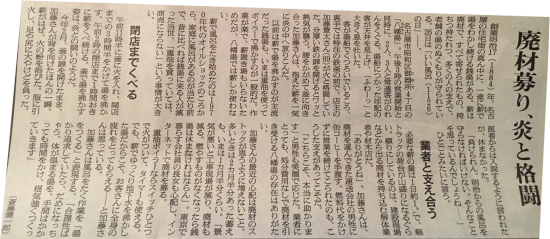 (English follows)
(English follows)
寒さが日増しに本格的になってきこの頃、皆様風邪などひかれていらっしゃらないでしょうか。八幡湯では11月の初め頃から、Twitter をはじめとしたSNS で皆様のご協力を賜りつつ八幡湯の廃材募集を続けています。そして、11/26 (いいふろ)の日の前日、朝日新聞 (夕刊) で廃材募集を続ける八幡湯をピックアップしていただきました。これもひとえに、ご愛顧くださる皆様のおかげです。本当にありがとうございます。

Have you ever heard of Hot Tub Day?
Japanese people love to take hot bath, and probably readers of this blog post love it to 😉 In the long Japanese history, hot bath has been loved as much as Onsen (Hot spring). It’s more convenient than Onsen because you don’t have to travel, and still has both physical and mental positive effects. This is the reason why most of all Japanese houses has hot bath tub, and Japanese people has custom to take bath almost every day. Current bath house spread in Edo era because it was recommended by the government for the healthier life of the citizen. SENTO (bath house) in Nagoya, Hachimanyu is following its traditional way to boil the bath by burning the woods.
On November 25th, a day before the Hot Tub Day (IIFURO NO HI – November 26th), Hachimanyu was on the Asashi Newspaper for keeping its traditional style and also its day to day challenges to go over the difficulty to keep up SENTO tradition. In the article, the concern on lack of the scrap wood (fuel to burn the water) is written.
Currently, Hachimanyu is calling out for the help to gather scrap woods by SNS (Twitter and FB). The above article would have never written without the kindness of the followers, re-tweeters, journalist of Asahi newspaper. Here, lastly but not as least, I’d like to express deep appreciation to all the warm comments and helps by spreading this little voice of traditional bath house in Nagoya, Japan. ARITGATO GOZAIMASU (Thank you very much) !!!